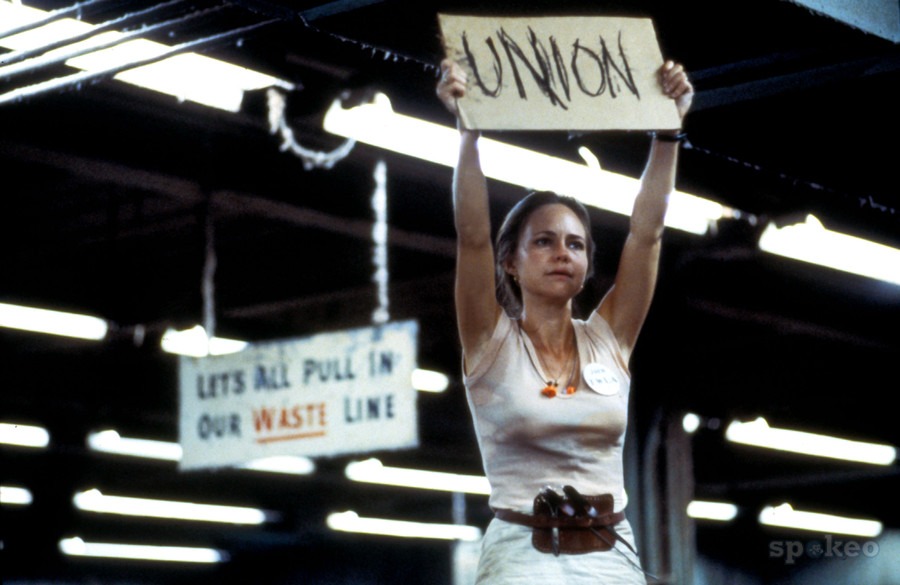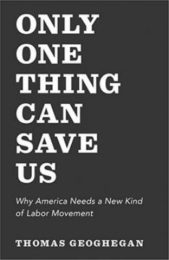When Ernesto Cortes, Jr., co-chair of the Industrial Areas Foundation, preaches about democracy in the U.S., he talks about the deterioration of our mediating institutions. We used to depend on our schools, our churches, our political parties, and our unions to mediate between the individual and the marketplace, the individual and the state. “The only way to revive our democracy,” says Cortes, “is by revitalizing the relationship-building within those institutions.”
Labor lawyer/writer Thomas Geoghegan agrees. And he’s pissed.
Organized labor is rapidly losing any remaining power it had. And it’s losing its way. In March, Wisconsin’s Governor Scott Walker signed the state’s right-to-work legislation into law. It became the 25th right-to-work state with Illinois, Missouri, and Kentucky waiting in the wings. National right-to-work legislation can’t be far behind.
Geoghegan says, bring it on.
Author of the much heralded Which Side Are You On? Trying to Be for Labor When It’s Flat on Its Back (1991), Geoghegan writes that re-organizing organized labor is “the only thing” that can get the middle class out of debt, that can get our government out of debt, that can reduce or eliminate our trade deficit, and, most important, that can “hold us together as a country and stop the growing inequality that in thirty years could bring the whole Republic crashing down.”
Re-organizing organized labor, writes Thomas Geoghegan, is “the only thing” that can get the middle class out of debt, that can get our government out of debt, that can reduce or eliminate our trade deficit, and, most important, that can “hold us together as a country and stop the growing inequality that in thirty years could bring the whole Republic crashing down.”
Much more important than the battle against right to work, for a country in which slightly more than 11 percent of the workforce is unionized, argues Geoghegan, is the battle to democratize the workplace. That requires government action, and it requires a new kind of organizing in which requiring union dues to be paid by all workers is secondary to workers having a say in the structure of the workplace, the skills needed for jobs, and salaries structured to reflect those skill levels. He believes legislators, and the corporations that pull their strings, might agree to more worker control in exchange for across-the-board right-to-work legislation.
Geoghegan grudgingly cites Germany, a right-to-work country. Labor elects half the directors on the corporate boards of large corporations, the corporations provide training for all workers, innovations rise from the shop floor instead of descending from management, and, as a result, union wages in Germany more than double the union wages paid in the U.S., creating a very healthy middle class. By contrast, U.S. corporations simplify jobs, making workers replaceable, thus keeping wages down, losing any benefit of ongoing teamwork, turning often to contract labor (with no benefits), and reducing the strength and purchasing power of the middle class. “Ford, GM, Boeing, Caterpillar, and others want us to be lower skilled,” writes Geoghegan.
Over 40 years, he writes, “the U.S. average hourly wage has dropped by 8 percent while output per worker has risen by 400 percent or more.” So this is not about reduced productivity. It’s about the returns on productivity going to a small investor class while the real producers lose economic ground. It is also about the profits going into a few pockets and not, by and large, being reinvested in the enterprise. If workers were half the decision-makers of a corporation, as with many large German firms, a large portion of the profits would be re-invested in the workers and in the business to sell more durable goods at home and abroad.
Without a change in the power relationships within corporations, Geoghegan argues, there will be no change in the economic well-being of the middle class, which has been the key driver of U.S. domestic prosperity. And so he thinks the Democrats are particularly weak when they say, as Obama did in a speech (Dec. 6, 2011) designed to attack the 1 percent, that “a higher education is the surest route to the middle class.” It’s important, writes Geoghegan, but without a change in labor power, these college grads can continue to expect to make $17 an hour.
The future of unions in this country, which Geoghegan sees as a necessary condition for the future of a democratic and prosperous country, can only be effected by recognizing union membership and action as a civil right—by banning employment discrimination based on union membership. Recognizing labor rights as civil rights opens the way for individuals and small groups to begin to agitate for change within corporations without fear of reprisal. This provides a real right to work while organizing the workplace. And it sets up the courts, instead of the National Labor Relations Board, as the forum to resolve organizing rights. Geoghegan seems to think this can happen, and if it doesn’t, he believes we may never recover.
Geoghegan argues that every labor action is political and should have greater meaning than just wages for workers. That’s why, he believes, organizing by teachers and nurses strikes a chord with the American public and will eventually succeed. Recent strikes by teachers and nurses have found broad public support in the streets and in some editorial pages, because they are not just about wages and hours, but also about safety, health, our children and our future as a community. They are the new model for organizing.
In 1961, Martin Luther King, Jr., told the AFL-CIO that labor needed a new design. King said, “Labor will have to intervene in the political life of the nation to chart a course which distributes the abundance to all instead of concentrating it among a few.”
More than five decades later, this work has begun only in isolated pockets. Thomas Geoghegan argues that we can’t wait any longer for this new organizing model to take hold.
Geoff Rips is a former Open Society Fellow of the Soros Foundation and author of UnAmerican Activities, The Truth, and most recently The Calculus of Falling Bodies, a book of poems.
This article appears in the June 2015 issue of The Washington Spectator.




I heartily agree! However, the labor movement (AFL-CIO) must recognize its own responsibility leading up to this sorry state. Unions must be as democratic as possible & union leadership responsible to the “rank & file” only. No more schmoozing with the bosses, no more kowtowing to Democratic Party hacks who want votes but offer nothing in return beyond hot air. Without a dynamic on-the-ground labor movement where leadership takes its cues from the membership & not “political consultants” there will be no change. In my personal experience, very few unions show any interest in organizing, particularly when there may be some real struggle involved.